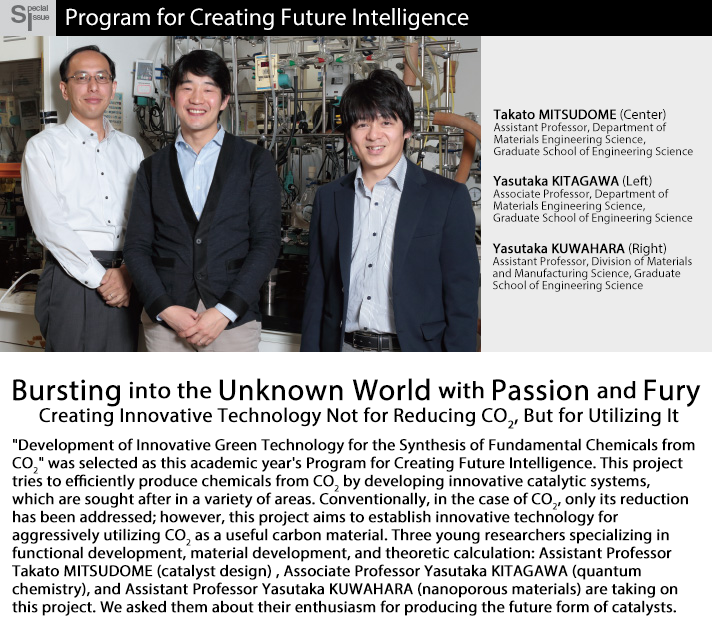Bursting into the Unknown World with Passion and Fury
Creating Innovative Technology Not for Reducing CO2, But for Utilizing It

A Positive Idea that Does Not Portray CO 2 as a Villain
The purpose of this research is producing useful substances from CO 2 by developing innovative catalysts. The feature of this technology is that it is not a technology for reducing CO 2 . "Many researchers have already made efforts to reduce CO 2 to zero. What we want to do is make a system to produce useful things from CO 2 , which is often demonized, to serve as a mechanism for changing its negative aspects into positive ones." Assistant Prof. Mitsudome, a representative of this research project, says. "This is a very challenging research project. Nobody has achieved something quite like this." Associate Prof. Kitagawa and Assistant Prof. Kuwahara say that their goal is to achieve unprecedented efficient reaction and establish advanced resource cycling technologies by developing new catalysts.
With Different Yet Complimentary Strengths, This Trio Makes Deeper and Wider Study Possible
Assistant Prof. Kuwahara has been involved in the development of nanoporous materials appropriate for catalysts. Based on such materials, Associate Prof. Kitagawa, with a knowledge of quantum chemistry, predicts the functions of these new materials, and Assistant Prof. Mitsudome, with knowledge of nanoscopic molecular conversion reaction, performs functional development and evaluation of catalysts. Through this process, they can conduct research that is "deep and wide," integrating different fields of study. "There are many research projects conducted at one laboratory, but they cannot deepen the three elements necessary for catalyst research: functional development, material development, and theoretic calculation. However, if the three of us join together, we can pursue all of these fields." Assistant Prof. Mitsudome says.
As soon as he learned of the Program for Creating Future Intelligence that aims to nurture ideas for science and technology for the future by supporting young researchers, Assistant Prof. Mitsudome directly called Associate Prof. Kitagawa (involved in the Department of Chemistry of the Graduate School of Science at the time) and Assistant Prof. Kuwahara and talked about the program in order to "reserve" them before other researchers would apply for the program together with the two.
To Assistant Prof. Mitsudome, these two researchers, who have been involved in exciting research, are important partners. Assistant Prof. Kuwahara spoke delightedly "Dr. Mitsudome and I have known each other since our days in the doctoral course. Even back then, he told me to get ready to work together."
Since they looked for a project in which they could utilize their specialties and protect the environment, they picked the theme of "Development of Innovative Green Technology for the Synthesis of Fundamental Chemicals from CO 2 ." "The theme was decided on very quickly while we were exchanging emails," Associate Prof. Kitagawa said.
Continuing to Run Towards the Unknown
The Program for Creating Future Intelligence is a three-year program, but they don't think this endeavor will end there. "We expect outstanding results, but the most important thing is to make systems that will lead into the future. We want to work on this program as the first step toward the future," Associate Prof. Kitagawa said.
Their activities at their laboratories have not been reduced because of the initiation of their joint research, but rather, the three have become busier. Said a frank Assistant Professor Mitsudome, "It's exactly what I wanted." Assistant Prof. Kuwahara continued, "Since this project is related to our own research, I think it will also be big advantage for us."
Asked about their goals, Associate Prof. Kitagawa said enthusiastically, "I'd like to continue to work full force." Assistant Prof. Kuwahara passionately falls in line with him, saying "I'm going to devote all of my strength." With their head held high, they say, "In order to open the path to the future science, we may delve into an unknown field, but that is exactly what we want." Assistant Prof. Mitsudome finishes proudly, "We may look like we're doing bizarre things, but that's alright. We want to continue to do unknown, exciting things."
------------------

MITSUDOME Takato, a graduate of Osaka University School of Engineering Science in 2001, he completed a doctoral course at the Graduate School of Engineering Science of Osaka University in 2006. He has a doctor's degree in Engineering. He became a specially appointed assistant professor at the Graduate School of Engineering Science in 2006. He has held his current position as an assistant professor since 2008. His specialty is catalyst design.

KITAGAWA Yasutaka, a graduate of Osaka University School of Science in 1998, he completed a doctoral course at the Graduate School of Science of Osaka University in 2003 and became an assistant professor at the Graduate School of Science in the same year. He has a doctor's degree in science and has held his current position as an associate professor since July 2014. His achievements have earned him the Osaka University Achievement Award in 2011 and the Presidential Award for Encouragement in Research in 2013. His specialty is quantum chemistry.

KUWAHARA Yasutaka, a graduate of the Osaka University School of Engineering in 2006, he completed a doctoral course at the Graduate School of Engineering of Osaka University in 2011. He has a doctor's degree in science. He served as a research scientist at the Georgia Institute of Technology, U.S.A., in 2011 and as a researcher at the National Institute of Advanced Industrial Science and Technology in 2012. He has held his current position as an assistant professor since April 2014. His specialties are materials chemistry, catalytic chemistry, and photochemistry.
Interview held in December 2014
